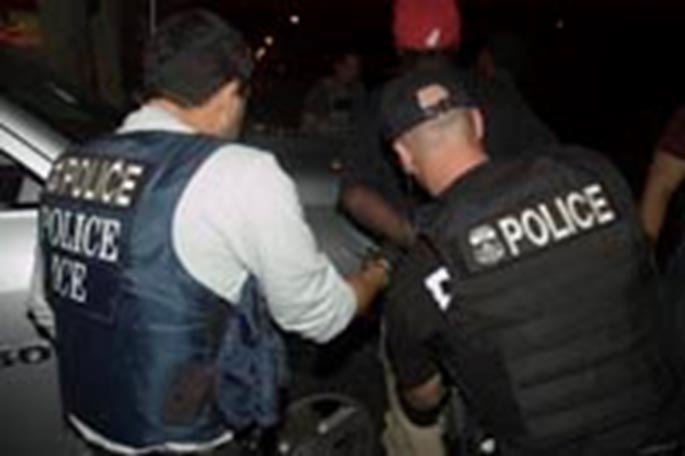Archived Content
In an effort to keep ICE.gov current, the archive contains content from a previous administration or is otherwise outdated. This information is archived and not reflective of current practice.
TOP STORY: ICE's top 10 anti-gang achievements
U.S. Immigration and Customs Enforcement (ICE) protects the United States by promoting homeland security and public safety through the criminal and civil enforcement of federal laws governing border control, customs, trade and immigration. To accomplish this mission, ICE coordinates with its federal, state, local and tribal partners to arrest and remove dangerous individuals during anti-gang operations and projects around the country.
Below are 10 of ICE's anti-gang achievements.
Operation Community Shield
ICE conducted its largest ever nationwide gang surge Oct. 1, 2008, during Operation Community Shield.
In the course of the ICE-led operation, 1,759 gang members and associates, criminals and immigration violators were arrested.
ICE announced March 1, 2011, the arrests of 678 gang members and associates from 133 different gangs during Project Southern Tempest, an intensive law enforcement operation executed in 168 U.S. cities targeting gangs affiliated with drug trafficking organizations.
During this operation ICE arrested the 20,000th gang member since inception of the anti-gang program in 2005.
Project Nefarious
The goal of Project Nefarious was to identify, locate, arrest, prosecute and remove gang members and associates affiliated with human smuggling and trafficking organizations.
ICE announced April 25, 2012, the arrests of 637 gang members and associates from 168 different gangs during Project Nefarious. The operation was executed in 150 U.S. cities and Honduras targeting transnational street gangs, prison gangs and outlaw motorcycle gangs involved with human smuggling and trafficking organizations.
Project Big Freeze
Project Big Freeze was the largest nationwide ICE-led enforcement operation targeting transnational gangs with ties to drug trafficking organizations.
ICE announced Jan. 27, 2010, the arrests of 476 gang members, associates and other criminals.
Crystal Palace
Oct. 16 2012, the results of a long-term probe, which dismantled one of San Diego County's largest single-day weapons seizures, and drug and gun trafficking rings involving members of 13 different Southern California gangs, are announced. Special agents from ICE seized a cache of 60 weapons during the two-year investigation dubbed.
This case was unique because of the number and type of weapons seized. The items included Uzi submachine guns, AR-15 rifles, shotguns, high-powered rifles with optics and laser sighting systems, silencers and a law enforcement Taser.
Operation Barbed Wire
The U.S. Department of the Treasury with the assistance of ICE designated the Latin American gang Mara Salvatrucha (MS-13) as a transnational criminal organization Oct. 11, 2012. MS-13 was the first transnational criminal street gang designated as a transnational criminal organization.
MS-13 was designated for its involvement in serious criminal activities, including drug trafficking, human smuggling and sex trafficking, murder and violence, racketeering, and immigration offenses. MS-13 is one of the most dangerous criminal gangs in the world today. MS-13 members have been responsible for numerous killings within the United States.
Operation Red Rein
The federal government indicted the majority of the 20th Street clique members of the Mara Salvatrucha (MS-13) gang Oct. 23, 2008.
Twenty-two individuals in the San Francisco Bay Area were indicted on federal racketeering and other charges arising from their participation in the MS-13.
Operation Devil Horns
When the federal government indicted the majority of the 20th Street clique members of the Mara Salvatrucha (MS-13) gang, Oct. 22, 2008, Danilo Velasquez, aka "Triste," assumed leadership.
Velasquez was sentenced to life in federal prison Feb. 15, 2012, on racketeering-related charges arising from Operation Devil Horns, a long-term probe led by ICE. Velasquez was described by a federal judge as a "vicious murderer."
Operation Red Tidings
Federal and local authorities announced the indictment May 3, 2012, of 19 members of a South San Francisco street gang on racketeering and other federal charges.
This indictment and the related arrests served as a warning to gangs about the consequences of using violence and fear to maintain control of their turf.
Three ICE special agents with were injured during the enforcement action. They were transported to a Bay area hospital for treatment of non-life threatening injuries. The indictment was the culmination of investigations originally initiated by the Daly City Police Department and the South San Francisco Police Department following separate shootings in those communities. The Daly City shooting occurred Dec. 18, 2010, and left three people injured. Four days later, a shooting in South San Francisco killed three individuals and wounded three others.
Rancho San Pedro Busts
More than 1,300 federal and local law enforcement officers fanned out April 28, 2011, across the Los Angeles harbor area to arrest 80 alleged members and associates of the Rancho San Pedro gang. The charges stem from a sweeping investigation involving more than a dozen federal, state and local agencies. During the course of the investigation, informants and undercover officers purchased 90 firearms along with significant quantities of cocaine, crack cocaine, methamphetamine, heroin and marijuana. During the takedown, officers seized an additional 14 firearms and a silencer.
The Los Angeles City Attorney's Office has filed a gang injunction and nuisance abatement actions against the gang. This is the first time a gang injunction and nuisance abatement lawsuits have been filed simultaneously in conjunction with the takedown of a major Southern California street gang.














